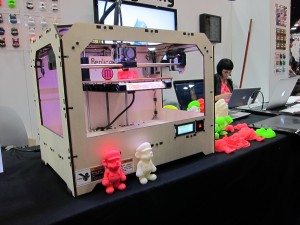In the 70s and 80s something new entered college laboratories and American garages—tinkers, makers, hackers, venture capitalists, and the simply curious were able to, for a few hundred to a few thousand dollars, get their hands on “modern” technology, a personal computer.
Computers at the time didn’t have a general user interface or software that you might recognize as useful or entertaining, but these early adopters, enthusiasts, and students would lay the foundation for the computer revolution of the 90s and the Internet revolution of the new millennium.
DIY 3D Printing
Today we’re at a similar point with another technology, 3D printing, also known as rapid prototyping. Because of more powerful computers, a variety of different methods are being used to, in essence, print or sculpt digital objects of almost any shape into physical reality. In 3D printing, a solid object is created by successive layering of materials, generally plastics, based on a digital model. Users can potentially create nearly any shape in plastic, within size limitations, that they can design. Some of the most common methods are Stereo lithography, Direct Metal Laser Sintering, Selective Laser Sintering, and Fused Deposition Modeling.
Fused Deposition Modeling, a form of additive manufacturing, is the only kind of 3D printing that is available at the consumer level—it’s basically a fancy way of saying computer-controlled plastic melter and printer. It can be found in products like the RepRap, the Makerbot, and the Solidoodle. These hobbyist machines, when properly calibrated, are capable of producing anything one can think of and can even make about one-third of their own parts, although according to one user, the manufacturer’s claims may be exaggerated.
A Local Experience
Early computer companies delivered products and kits that were difficult to build and were even harder to use, and that promised more than they could deliver. Using the current crop of consumer-level 3D printer kits is, according to Allen Brown, a local 3D printer hobbyist and member of Corvallis-Techgroup, “much more complicated than just buying it—there are things about these printers that are undocumented and non-obvious.”
Just calibrating the device took Brown a tremendous amount of time and effort. Other than the few pyramids printed during calibration, he and his friends did not succeed in getting the device to function as advertised.

Yoda Printed by a Solidoodle
Brown and his group of friends have tinkered with several different consumer-grade printers like the RepRap and the Solidoodle. With the RepRap, Brown personally sank more than $2,000 into parts and printing materials. After months of banging their collective heads against the wall, Brown and his friends moved on to the Solidoodle which was not much better than the RepRap.
Brown said that he got into this hobby because he wanted to use his own designs to create things. However, creating the 3D images turned out to be quite a challenge. The software, he said, was “much harder than it needed to be.” Despite all these challenges he also said that, “If you can find someone to help you and you have the time, money, and patience, this is a great thing to do. It’s just not for those looking for an easy project.”
Much like computers in the 80s, 3D printers are not ready for the average consumer, but these technologies are doing amazing things in the laboratory and on manufacturing floors around the nation.
Corvallis’ Hytek Precision Plastics
Hytek Precision Plastics, a local company started by Morris Coville, does a form of 3D manufacturing. Unlike the additive manufacturing process, Hytek designs and fabricates via welding, extrusion, or reduction. It’s more similar to sculpture than printing; instead of layering materials, they start with a solid piece of plastic that they bend, shape, etch, or mill into the desired shape.
Hytek uses precision tools to complete very niche production projects for the state and for aerospace manufacturers in the region. They also work on projects for industrial and commercial companies, educational institutions, and even for individuals.
One of their precision tools is something called a computer numerical control router (CNC). It is used to precisely cut or mill away infinitesimally small pieces or cut intricate patterns, impossible to replicate with human hands. They also produce molded parts that are then precisely cut with a CNC router and welded together to make a seamless product. All of the projects that Hytek designs and produces are made of plastic.
Hytek designs and fabricates work for local schools as well. According to Shelly Lara, manager at Hytek, “These are generally onesie twosie project runs, they made for example little black boxes with one clear side designed to hold fish for an OSU research project.”
Hytek also worked with OSU on its wave energy project by producing the tsunami wave tank. The company has donated quite a bit to the university by producing specialty made pieces for graduate students. Hytek also works with a robotics team at Crescent Valley High School.
“The college and high school kids come out here and we donate materials for them to work with; we also give them advice and guidance,” Lara said.

The Makerbot 3D Printer at Comicon 2012
The Future of 3D Printing
The printers and manufacturers that will really change the world are the kind that OSU mechanical engineering students Michael Dexter and David Calhoun want to build. They want to start a company, DNC Precision Manufacturing, to make use of a large-build Selective Laser Sintering 3D printer. It would be for direct metal projects and it would make products with full mechanical properties devoid of defects, only requiring a small amount of clean-up in terms of aesthetics and the smoothness of the product.
Current printers capable of this are small-build format, generally capable of producing objects that are less than 22 cubic inches. Dexter said that this limits its use. What he and his partner are trying to do is to start a company that uses a 3D printer that has a 4-foot by 4-foot by 6-foot buildable space. This would open up possibilities for “printing out” functional engines for automobiles or airplanes or any other component, regardless of its complexity.
According to Dexter, this is the new way that items are going to be manufactured. Standard manufacturing methods face limitations and drawbacks that don’t impede 3D printing.
“This is a complementary evolution to standard manufacturing; anything smaller than 500 units or projects with complex geometries that can’t be manufactured in one component are the kinds of projects our company will excel at,” he said.
One example of the kinds of projects that could be made available by Dexter and Calhoun’s company is Conformal cooling channels. The channels would be implemented in engine molds and turbine blades. They run along the edges of surfaces or coil in the middle of a blade so you can get liquid into the structure and super efficiently remove heat. This kind of manufacturing is very easy, and can be done at no additional cost with 3D printing. It is, however, almost impossible for traditional manufacturing to produce this kind of structure.
The future of 3-D printing isn't limited to industrial uses or even hobbyist creations. 3-D printing technologies can be adapted for the creation of biomedical implants as was the case with company
Oxford Performance Materials. Their "OsteoFab™ Patient Specific Cranial Device", which was recently approved by the FDA, was implanted in the skull of an American replacing nearly 75% of his original bone structure.
While there is definitely a tremendous amount of hype building around the promise of consumer-grade 3D printing, this country’s manufacturing sector is going to need hobbyists like Brown, companies like Hytek, and entrepreneurs like Dexter and Calhoun in order to stay competitive in the global manufacturing industry.
Related Links
Conformal Cooling Channels
3-D printed skull that was implanted in a human.
National Additive Manufacturing Innovation Insitute


